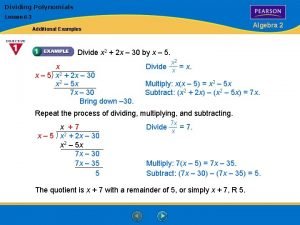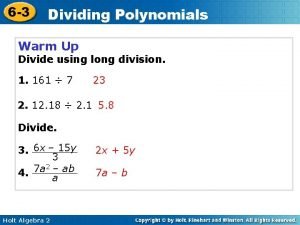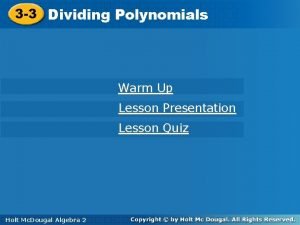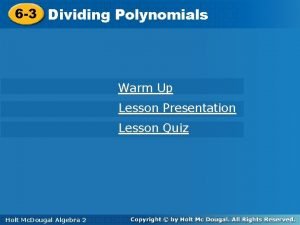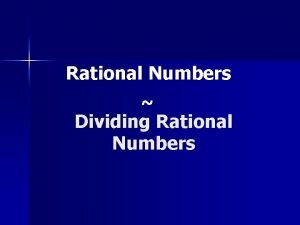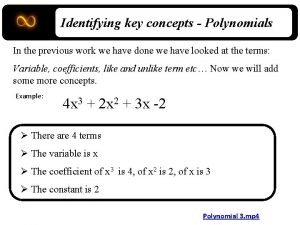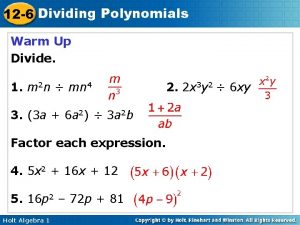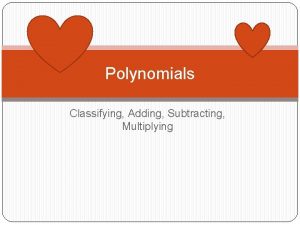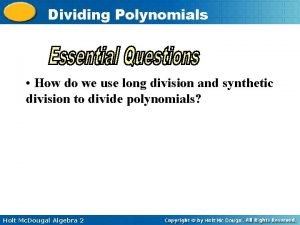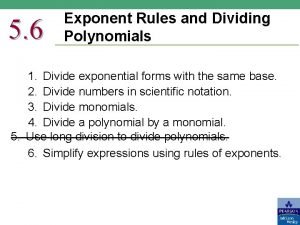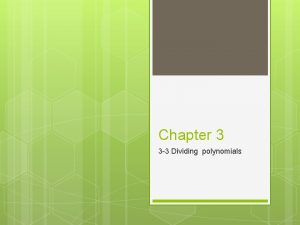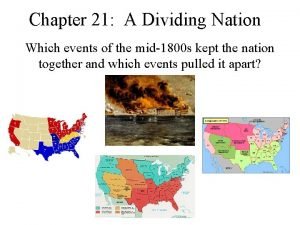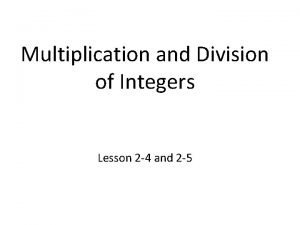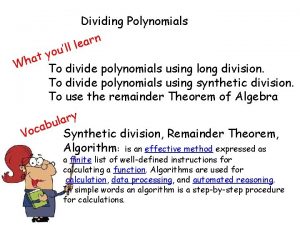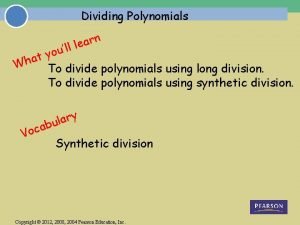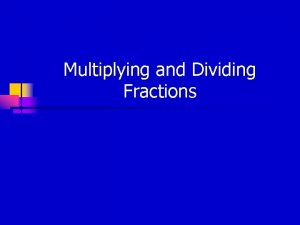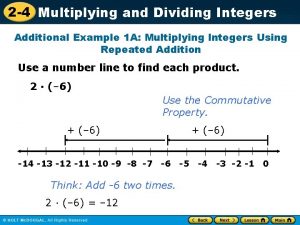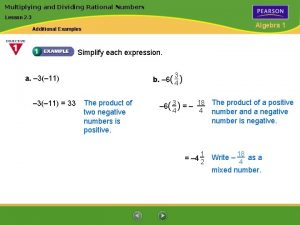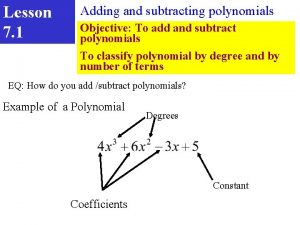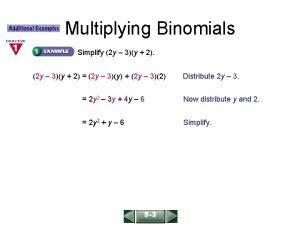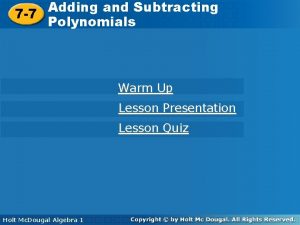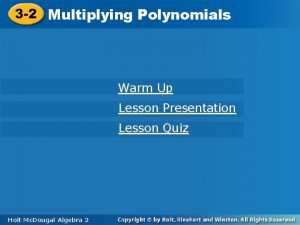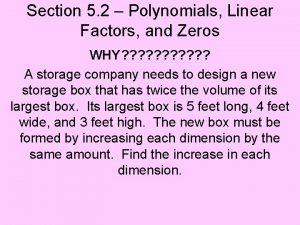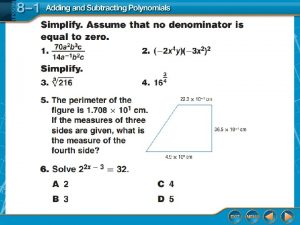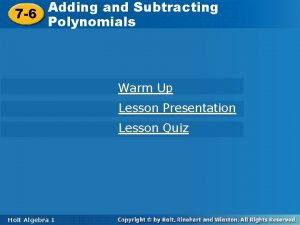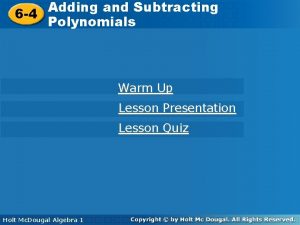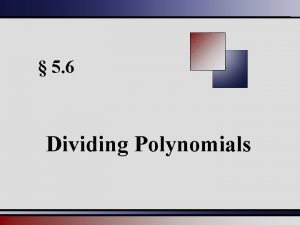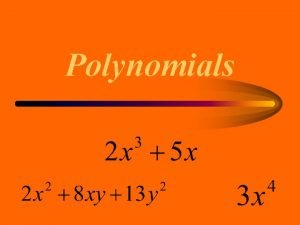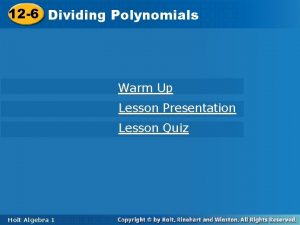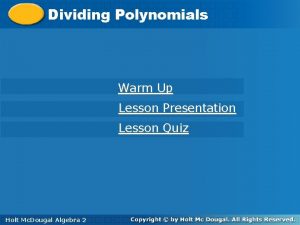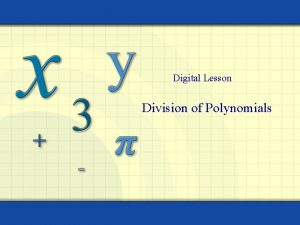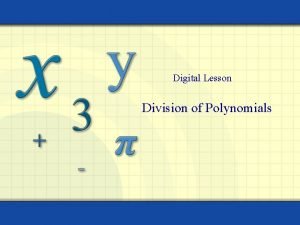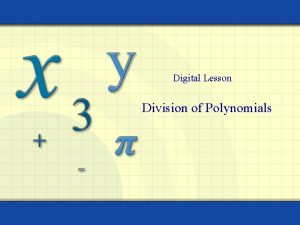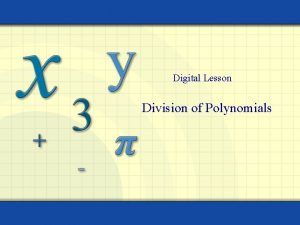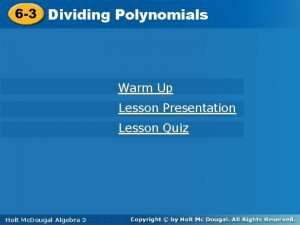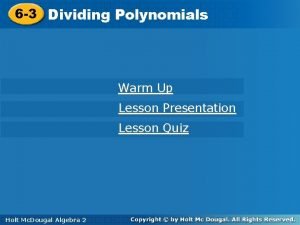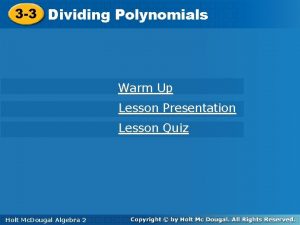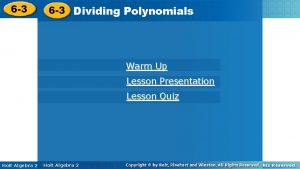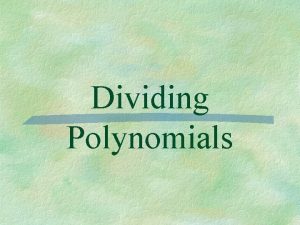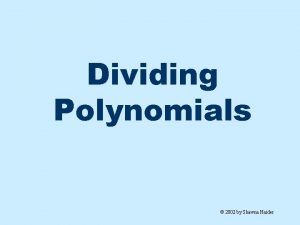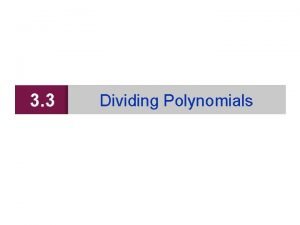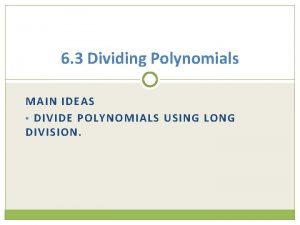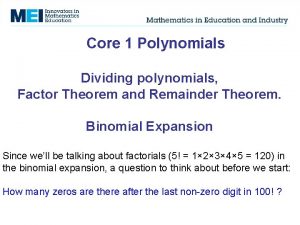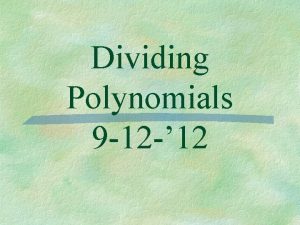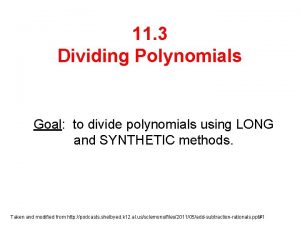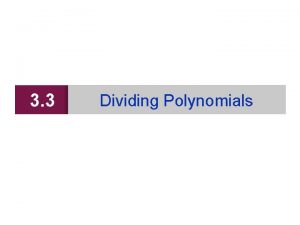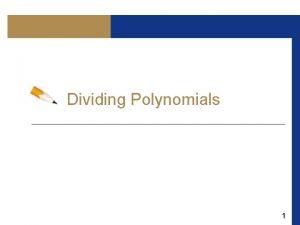3 3 Dividing Polynomials Warm Up Lesson Presentation


































- Slides: 34

3 -3 Dividing Polynomials Warm Up Lesson Presentation Lesson Quiz Holt Mc. Dougal Algebra 2 Algebra 22 Holt Mc. Dougal

3 -3 Dividing Polynomials Warm Up Divide using long division. 1. 161 ÷ 7 23 2. 18 ÷ 2. 1 5. 8 Divide. 3. 6 x – 15 y 3 2 – ab 7 a 4. a Holt Mc. Dougal Algebra 2 2 x + 5 y 7 a – b

3 -3 Dividing Polynomials Objective Use long division and synthetic division to divide polynomials. Holt Mc. Dougal Algebra 2

3 -3 Dividing Polynomials Vocabulary synthetic division Holt Mc. Dougal Algebra 2

3 -3 Dividing Polynomials Polynomial long division is a method for dividing a polynomial by another polynomials of a lower degree. It is very similar to dividing numbers. Holt Mc. Dougal Algebra 2

3 -3 Dividing Polynomials Example 1: Using Long Division to Divide a Polynomial Divide using long division. (–y 2 + 2 y 3 + 25) ÷ (y – 3) Step 1 Write the dividend in standard form, including terms with a coefficient of 0. 2 y 3 – y 2 + 0 y + 25 Step 2 Write division in the same way you would when dividing numbers. y – 3 2 y 3 – y 2 + 0 y + 25 Holt Mc. Dougal Algebra 2

3 -3 Dividing Polynomials Example 1 Continued Step 3 Divide. 2 y 2+ 5 y + 15 y – 3 2 y 3 – y 2 + 0 y + 25 –(2 y 3 – 6 y 2) 5 y 2 + 0 y –(5 y 2 – 15 y) 15 y + 25 –(15 y – 45) 70 Holt Mc. Dougal Algebra 2 Notice that y times 2 y 2 is 2 y 3. Write 2 y 2 above 2 y 3. Multiply y – 3 by 2 y 2. Then subtract. Bring down the next term. Divide 5 y 2 by y. Multiply y – 3 by 5 y. Then subtract. Bring down the next term. Divide 15 y by y. Multiply y – 3 by 15. Then subtract. Find the remainder.

3 -3 Dividing Polynomials Example 1 Continued Step 4 Write the final answer. –y 2 + 2 y 3 + 25 y– 3 Holt Mc. Dougal Algebra 2 = 2 y 2 70 + 5 y + 15 + y – 3

3 -3 Dividing Polynomials Check It Out! Example 1 a Divide using long division. (15 x 2 + 8 x – 12) ÷ (3 x + 1) Step 1 Write the dividend in standard form, including terms with a coefficient of 0. 15 x 2 + 8 x – 12 Step 2 Write division in the same way you would when dividing numbers. 3 x + 1 15 x 2 + 8 x – 12 Holt Mc. Dougal Algebra 2

3 -3 Dividing Polynomials Check It Out! Example 1 a Continued Step 3 Divide. 5 x + 1 3 x + 1 15 x 2 + 8 x – 12 –(15 x 2 + 5 x) 3 x – 12 –(3 x + 1) – 13 Holt Mc. Dougal Algebra 2 Notice that 3 x times 5 x is 15 x 2. Write 5 x above 15 x 2. Multiply 3 x + 1 by 5 x. Then subtract. Bring down the next term. Divide 3 x by 3 x. Multiply 3 x + 1 by 1. Then subtract. Find the remainder.

3 -3 Dividing Polynomials Check It Out! Example 1 a Continued Step 4 Write the final answer. 15 x 2 + 8 x – 12 13 = 5 x + 1 – 3 x + 1 Holt Mc. Dougal Algebra 2

3 -3 Dividing Polynomials Check It Out! Example 1 b Divide using long division. (x 2 + 5 x – 28) ÷ (x – 3) Step 1 Write the dividend in standard form, including terms with a coefficient of 0. x 2 + 5 x – 28 Step 2 Write division in the same way you would when dividing numbers. x– 3 Holt Mc. Dougal Algebra 2 x 2 + 5 x – 28

3 -3 Dividing Polynomials Check It Out! Example 1 b Continued Step 3 Divide. x +8 x – 3 x 2 + 5 x – 28 –(x 2 – 3 x) 8 x – 28 –(8 x – 24) – 4 Holt Mc. Dougal Algebra 2 Notice that x times x is x 2. Write x above x 2. Multiply x – 3 by x. Then subtract. Bring down the next term. Divide 8 x by x. Multiply x – 3 by 8. Then subtract. Find the remainder.

3 -3 Dividing Polynomials Check It Out! Example 1 b Continued Step 4 Write the final answer. x 2 + 5 x – 28 x– 3 Holt Mc. Dougal Algebra 2 4 =x+8–x– 3

3 -3 Dividing Polynomials Synthetic division is a shorthand method of dividing a polynomial by a linear binomial by using only the coefficients. For synthetic division to work, the polynomial must be written in standard form, using 0 and a coefficient for any missing terms, and the divisor must be in the form (x – a). Holt Mc. Dougal Algebra 2

3 -3 Dividing Polynomials Holt Mc. Dougal Algebra 2

3 -3 Dividing Polynomials Example 2 A: Using Synthetic Division to Divide by a Linear Binomial Divide using synthetic division. (3 x 2 + 9 x – 2) ÷ (x – 1 ) 3 Step 1 Find a. Then write the coefficients and a in the synthetic division format. a= 1 3 3 For (x – 1 ), a = 31. 3 9 – 2 Holt Mc. Dougal Algebra 2 Write the coefficients of 3 x 2 + 9 x – 2.

3 -3 Dividing Polynomials Example 2 A Continued Step 2 Bring down the first coefficient. Then multiply and add for each column. 1 3 3 9 – 2 1 31 3 3 10 1 1 3 Draw a box around the remainder, 1 31. Step 3 Write the quotient. 11 3 3 x + 10 + 1 x– 3 Holt Mc. Dougal Algebra 2

3 -3 Dividing Polynomials Example 2 A Continued 11 3 Check Multiply (x – 1 ) 3 x + 10 + 3 1 x– 3 11 1 ) 3 (x – 1 ) (x – 3 x + 10 + 3 3 3 1 x– 3 = 3 x 2 + 9 x – 2 Holt Mc. Dougal Algebra 2

3 -3 Dividing Polynomials Example 2 B: Using Synthetic Division to Divide by a Linear Binomial Divide using synthetic division. (3 x 4 – x 3 + 5 x – 1) ÷ (x + 2) Step 1 Find a. a = – 2 For (x + 2), a = – 2. Step 2 Write the coefficients and a in the synthetic division format. – 2 3 – 1 Holt Mc. Dougal Algebra 2 0 5 – 1 Use 0 for the coefficient of x 2.

3 -3 Dividing Polynomials Example 2 B Continued Step 3 Bring down the first coefficient. Then multiply and add for each column. – 2 3 – 1 0 5 – 1 – 6 14 – 28 46 Draw a box around the remainder, 45. 3 – 7 14 – 23 45 Step 4 Write the quotient. 3 x 3 – 7 x 2 + 14 x – 23 + Holt Mc. Dougal Algebra 2 45 x+2 Write the remainder over the divisor.

3 -3 Dividing Polynomials Check It Out! Example 2 a Divide using synthetic division. (6 x 2 – 5 x – 6) ÷ (x + 3) Step 1 Find a. a = – 3 For (x + 3), a = – 3. Step 2 Write the coefficients and a in the synthetic division format. – 3 6 – 5 – 6 Holt Mc. Dougal Algebra 2 Write the coefficients of 6 x 2 – 5 x – 6.

3 -3 Dividing Polynomials Check It Out! Example 2 a Continued Step 3 Bring down the first coefficient. Then multiply and add for each column. – 3 6 – 5 – 6 – 18 69 6 Draw a box around the remainder, 63. – 23 63 Step 4 Write the quotient. 6 x – 23 + Holt Mc. Dougal Algebra 2 63 x+3 Write the remainder over the divisor.

3 -3 Dividing Polynomials Check It Out! Example 2 b Divide using synthetic division. (x 2 – 3 x – 18) ÷ (x – 6) Step 1 Find a. a=6 For (x – 6), a = 6. Step 2 Write the coefficients and a in the synthetic division format. 6 1 – 3 – 18 Holt Mc. Dougal Algebra 2 Write the coefficients of x 2 – 3 x – 18.

3 -3 Dividing Polynomials Check It Out! Example 2 b Continued Step 3 Bring down the first coefficient. Then multiply and add for each column. 6 1 1 – 3 – 18 6 18 3 0 There is no remainder. Step 4 Write the quotient. x+3 Holt Mc. Dougal Algebra 2

3 -3 Dividing Polynomials You can use synthetic division to evaluate polynomials. This process is called synthetic substitution. The process of synthetic substitution is exactly the same as the process of synthetic division, but the final answer is interpreted differently, as described by the Remainder Theorem. Holt Mc. Dougal Algebra 2

3 -3 Dividing Polynomials Example 3 A: Using Synthetic Substitution Use synthetic substitution to evaluate the polynomial for the given value. P(x) = 2 x 3 + 5 x 2 – x + 7 for x = 2. 2 2 5 – 1 2 4 9 7 18 34 17 41 Write the coefficients of the dividend. Use a = 2. P(2) = 41 Check Substitute 2 for x in P(x) = 2 x 3 + 5 x 2 – x + 7. P(2) = 2(2)3 + 5(2)2 – (2) + 7 P(2) = 41 Holt Mc. Dougal Algebra 2

3 -3 Dividing Polynomials Example 3 B: Using Synthetic Substitution Use synthetic substitution to evaluate the polynomial for the given value. 1 P(x) = 6 x 4 – 25 x 3 – 3 x + 5 for x = –. 3 1 Write the coefficients of 6 – 25 0 – 3 5 – 3 the dividend. Use 0 for – 2 9 – 3 2 the coefficient of x 2. Use 1 6 – 27 9 – 6 7 a=. 3 1 P( ) = 7 3 Holt Mc. Dougal Algebra 2

3 -3 Dividing Polynomials Check It Out! Example 3 a Use synthetic substitution to evaluate the polynomial for the given value. P(x) = x 3 + 3 x 2 + 4 for x = – 3 1 3 0 4 – 3 0 0 1 0 0 4 P(– 3) = 4 Write the coefficients of the dividend. Use 0 for the coefficient of x 2 Use a = – 3. Check Substitute – 3 for x in P(x) = x 3 + 3 x 2 + 4. P(– 3) = (– 3)3 + 3(– 3)2 + 4 P(– 3) = 4 Holt Mc. Dougal Algebra 2

3 -3 Dividing Polynomials Check It Out! Example 3 b Use synthetic substitution to evaluate the polynomial for the given value. P(x) = 5 x 2 + 1 5 9 5 10 P( 1 ) = 5 5 Holt Mc. Dougal Algebra 2 9 x + 3 for x = 3 2 5 1. 5 Write the coefficients of 1 the dividend. Use a =. 5

3 -3 Dividing Polynomials Example 4: Geometry Application Write an expression that represents the area of the top face of a rectangular prism when the height is x + 2 and the volume of the prism is x 3 – x 2 – 6 x. The volume V is related to the area A and the height h by the equation V = A h. Rearranging for A gives A = V. h 3 – x 2 – 6 x x A(x) = Substitute. x+2 – 2 1 – 6 0 – 2 6 0 1 – 3 0 0 Holt Mc. Dougal Algebra 2 Use synthetic division. The area of the face of the rectangular prism can be represented by A(x)= x 2 – 3 x.

3 -3 Dividing Polynomials Check It Out! Example 4 Write an expression for the length of a rectangle with width y – 9 and area y 2 – 14 y + 45. The area A is related to the width w and the length l by the equation A = l w. l(x) = 9 y 2 – 14 y + 45 y– 9 Substitute. 1 – 14 45 Use synthetic division. 9 – 45 1 – 5 0 The length of the rectangle can be represented by l(x)= y – 5. Holt Mc. Dougal Algebra 2

3 -3 Dividing Polynomials Lesson Quiz 1. Divide by using long division. 33 3 2 2 (8 x + 6 x + 7) ÷ (x + 2) 8 x – 10 x + 20 – x+2 2. Divide by using synthetic division. 3 2 (x 3 – 3 x + 5) ÷ (x + 2) x – 2 x + 1 + x + 2 3. Use synthetic substitution to evaluate 194; – 4 3 2 P(x) = x + 3 x – 6 for x = 5 and x = – 1. 4. Find an expression for the height of a parallelogram whose area is represented by 2 x 3 – x 2 – 20 x + 3 and whose base is 2 x 2 – 7 x + 1 represented by (x + 3). Holt Mc. Dougal Algebra 2

3 -3 Dividing Polynomials Homework – Long Division Pg 170 #2 -4 , 13 -18 2. 3. 4. 13. 14. 15. 16. 17. 18. (20 x 2 – 13 x + 2) ÷ ( 4 x – 1) (x 2 + x – 1) ÷ ( x – 1) (x 2 - 2 x + 3) ÷ ( x + 5) (2 x 2 + 10 x + 8) ÷ ( 2 x + 2) (9 x 2 - 18 x) ÷ ( 3 x) (x 3 + 2 x 2 - x - 2) ÷ ( x + 2) (x 4 - 3 x 3 – 7 x - 14) ÷ ( x - 4) (x 6 - 4 x 5 – 7 x 3) ÷ ( 2 x 3) (6 x 2 - 7 x - 5) ÷ ( 3 x - 5) Holt Mc. Dougal Algebra 2
 Divide polynomials
Divide polynomials 6-3 dividing polynomials
6-3 dividing polynomials 3-4 lesson quiz dividing polynomials
3-4 lesson quiz dividing polynomials Lesson 6-5 dividing polynomials worksheet answers
Lesson 6-5 dividing polynomials worksheet answers Multiplying and dividing rational numbers jeopardy
Multiplying and dividing rational numbers jeopardy How can we use polynomials in real life
How can we use polynomials in real life Dividing polynomials math lib
Dividing polynomials math lib Monomial division
Monomial division Dividing polynomials by binomials
Dividing polynomials by binomials Unit 5: polynomial functions
Unit 5: polynomial functions Adding subtracting multiplying and dividing polynomials
Adding subtracting multiplying and dividing polynomials How to divide polynomials using long division
How to divide polynomials using long division How to do substitution
How to do substitution 5-2 dividing polynomials
5-2 dividing polynomials Rules for dividing polynomials
Rules for dividing polynomials Dividing polynomials using synthetic division worksheet
Dividing polynomials using synthetic division worksheet 11-5 practice dividing polynomials answer key
11-5 practice dividing polynomials answer key How did the raid on lawrence, kansas pull the nation apart
How did the raid on lawrence, kansas pull the nation apart Multiplying integers lesson
Multiplying integers lesson Lesson 6 dividing by x-a and by x+a
Lesson 6 dividing by x-a and by x+a Lesson 6 dividing by x-a and by x+a
Lesson 6 dividing by x-a and by x+a Lesson 6 dividing by x-a and by x+a
Lesson 6 dividing by x-a and by x+a Multiplying and dividing fractions lesson
Multiplying and dividing fractions lesson Lesson 2-4 multiplying and dividing integers answers
Lesson 2-4 multiplying and dividing integers answers Lesson 2-4 multiplying and dividing integers answers
Lesson 2-4 multiplying and dividing integers answers Algebra 1 examples
Algebra 1 examples Adding and subtracting polynomials
Adding and subtracting polynomials Lesson 9 multiplying polynomials
Lesson 9 multiplying polynomials 7-1 adding and subtracting polynomials
7-1 adding and subtracting polynomials 4ab2-2ab+6bc2
4ab2-2ab+6bc2 Polynomials linear factors and zeros
Polynomials linear factors and zeros Lesson 8: adding and subtracting polynomials
Lesson 8: adding and subtracting polynomials 7-1 adding and subtracting polynomials
7-1 adding and subtracting polynomials 6.1 adding and subtracting polynomials
6.1 adding and subtracting polynomials Factoring special products examples
Factoring special products examples
